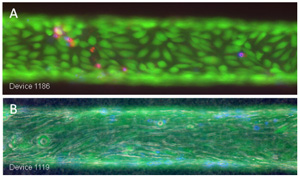
The Kidney Project in the Predictive Toxicology Center designs, implements and tests a tissue-engineered human kidney microphysiological system. The system is developed to fully evaluate uptake, metabolism and elimination of xenobiotics in a human tissue-derived, in vitro 3D system that accurately reflects human kidney physiology. The microphysiological system can be used to predict disposition kinetics of xenobiotics, and also assess the response to kidney injury inflicted by endogenous and exogenous toxicants, as well as from pathogens. We identify the specific markers that are most useful in defining dynamic cellular responses to nanomaterial and other chemical exposures to the kidney. Responses that will be evaluated include organ-specific injury (kidney injury molecule-1, KIM1) as well as general toxicity responses such as cytotoxicity and oxidative stress markers (oxidative stress and ER stress).
